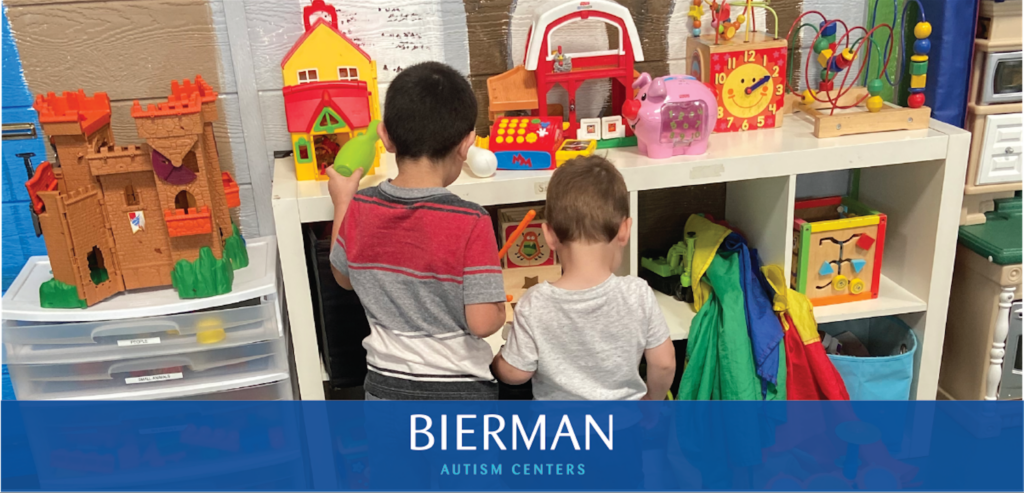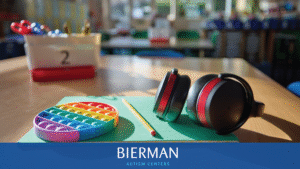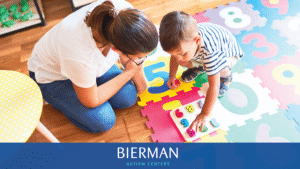Play skills for your child with autism benefit your child and their development. Understanding the different stages of play will help you interact with them and find their strengths and skill level. We recommend setting goals for yourself and your child during play and thinking about what you want to accomplish during each play session. When it comes to playing, the most important thing is to have fun; we advise you to follow some of these steps to ensure a joyful and effective play experience.
Stages of play
● Solitary Play: Playing solo without attending to others around you
● Onlooker Play: Also playing solo, but the child may be watching others play
● Parallel Play: Playing near others or with similar toys but not necessarily interacting with the other individuals around them
● Associative Play: Sharing toys and communicating with others during play
● Cooperative Play: Playing with others with a common goal
● Pretend Play: Experimenting with different social and emotional roles
Benefits of pretend play
Pretend play allows your child to explore their environment and communicate with others, sparking their imagination.
Let’s now dive into the two types of pretend play:
Symbolic Pretend Play
This level of play includes object substitution or completing real actions with pretend items. For example, your child uses pots and pans as hats and musical instruments. We know that these are not the actual functions of these items. Clearly, your child has identified similarities between the items they’re using and the items that these objects are subbing for. This is where the name object substitution comes from. To understand those similarities and before being able to engage in this type of play, some additional skills would be required, and we call these things component skills. An example of component skills that would be required before engaging in symbolic play would be having a vocabulary of a hundred words or more or understanding the size and shape of objects in comparison to other objects.
Advanced Pretend Play
Advanced pretend play involves creating roles and using props. To understand the complexities of this kind of play, a child must learn certain components and skills. For example, the ability to sort items by class, feature, or function.
Now let’s go into a few tips on interacting and engaging with your child!
Setting up a play session with your child.
The first step is creating a goal. You can ask yourself, what does your child’s play look like now? What would you like your child’s play to look like? These are goals that you can set for yourself and your child. When creating a goal, the most important thing is to start small and think about what’s realistic for your child. Some examples might be:
● Imitating a simple action that you complete with their toy
● Your child remains in the room as you sit next to them and watch them play
● Initiating play without your guidance
● Playing independently with a toy in a functional way
● Taking turns with the toy
How do I know what my child is ready for?
Start by looking or observing and check and see if your child has any missing skills. If they aren’t able to do these skills independently, there’s always a way that we can physically assist them, or we could practice something different. For example, when doing a puzzle, some skills that would be needed to complete a puzzle are picking up the piece and matching it to the correct space. If this is difficult for them, try completing puzzles that already have the pictures underneath.
Select the activity and materials
The materials are sometimes key if your child is struggling with a certain skill area. When you’re thinking about selecting the materials, think back about what your ultimate
goal is when selecting those materials. For example, when targeting sharing, try to choose items with multiple pieces, so you can have repeated sharing opportunities. That repetition will help your child to understand the expectation.
Set up the environment
A way to set up the environment is to minimize distractions. You can do that by removing other toys from the environment or decluttering the space. If you know your child goes to different toys frequently or a toy doesn’t necessarily hold their attention, you can remove other toys so that they only have the option to play with that one toy at that time.
Be involved
When it comes to your child’s play, your child may not naturally engage with toys according to their function. You can get involved by observing their natural play behavior. Ask yourself:
● What toys do they gravitate toward? Use those in-play interactions.
● How do they like to play with those items? Model their behavior at first and then add new play actions.
● Do they already have trouble with someone else manipulating their toys? If so, it might be good to start playing near them instead of trying to use the same toys.
Thinking about things will help you to guide your interaction with them. Try to meet your child where they are and focus on making your play experience as positive as possible by easing yourself into that interaction.
Let’s celebrate
You should celebrate whenever your child is learning to play in new ways and tolerate new things in their environment. You can reward that new play behavior by repeating it, or you expand on that imitation and do other cool things with the rocket ship.
Things to avoid
While there are many ways that you can make an activity more fun, there are also things that you may be doing that are doing the opposite. How do you know if you’re making it not so fun? Just try to observe your child’s behavior. Your child may walk away from you, turn their body, or move toys to a different space. Some examples of this are asking too many questions. That might make the activity more difficult for your child, especially if they’re used to playing by themselves with that item. A great alternative to asking them questions would be to narrate what they’re doing. Instead of saying, what is that, what color is this, or tell me what this is? You could say, that’s a doll. The doll’s going to sleep; narrate some things you see within their play items. Removing toys from their hands is also something that can be triggering for them, especially when you’re trying to teach them something new. An alternative to this could be to have plenty of extra play materials to model play with your objects without having to take the items from your child. Be mindful of those subtle cues about them not enjoying the interaction, and try to follow their lead and adjust your behavior to see if you can make it more enjoyable for them.
Putting it all together
Now that we discussed the different aspects of playing with your child let’s review some examples of what that play might look like. If your child wants to engage in a puzzle, you could focus on or imitate putting in a puzzle piece. You could also work on independent, functional play. Just making sure that they can complete the puzzle on their own or they’re able to follow simple directions. Another toy that you might want to use is a cause-and-effect toy. Some different things you can focus on here are imitating and pushing the different colored buttons. You can push the buttons, and then your child pushes the buttons as well. You could label the different colors or say, “Where’s the yellow? Find the purple.” Lastly, we have an exploratory play. Exploratory play is one of the first stages of play that most kids start with. One thing to consider is how many actions that toy can do. For most kids, it’s easiest to learn a toy when there’s only one action to start. It might be pushing buttons, or it might be putting a coin into a slot.
Some of the key takeaways of this guide are to create goals and to keep those goals in mind when you’re teaching them your new play skills. You also want to select appropriate toys. Set up the environment, be observant and involved, and adjust your interactions based on your child. Remember to be flexible within the expectations that you set up and meet them where they are.
Note: This blog post is based on a Bierman ABA Caregiver Webinar


